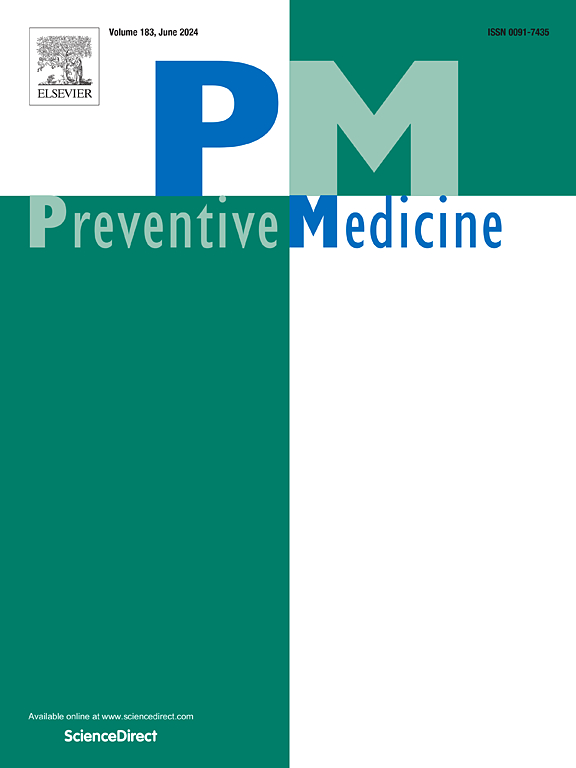酒精暴露妊娠(含或不含烟草和大麻)的不良出生结局
IF 3.2
2区 医学
Q1 MEDICINE, GENERAL & INTERNAL
引用次数: 0
摘要
目的探讨诊断为酒精使用、单独使用或合并大麻或烟草使用的孕妇早产(PTB)和小胎龄儿(SGA)的风险。方法将加州出生证明(2007-2021年)的数据与母婴住院记录相关联。产妇ICD 9-10代码显示药物使用诊断。我们计算了在单独饮酒与酒精合并烟草和/或大麻的诊断中,极端/非常PTB(妊娠32周)、晚期PTB(32 - 36周)和SGA(出生体重第10百分位)的调整风险比(aRR)和95%置信区间(CIs)。结果与单独饮酒相比,同时发生的酒精和烟草与极端/非常PTB (aRR = 1.44, 95% CI = 1.09, 1.89)、晚期PTB (aRR = 1.25, 95% CI = 1.12, 1.40)和SGA婴儿(aRR = 1.31, 95% CI = 1.19, 1.44)的风险相关。有酒精和大麻的个体发生SGA婴儿的风险增加(aRR = 1.21, 95% CI = 1.05, 1.38)。有这三种药物适应症的婴儿患极端/非常PTB (aRR = 1.68, 95% CI = 1.17, 2.40)和SGA婴儿(aRR = 1.29, 95% CI = 1.13, 1.48)的风险更高。结论:在有酒精诊断的人群中,与单独饮酒相比,产前同时接触烟草或不接触大麻与PTB和SGA的风险增加有关。筛查和解决产前多物质使用应优先考虑。本文章由计算机程序翻译,如有差异,请以英文原文为准。
Adverse birth outcomes in alcohol-exposed pregnancies with or without tobacco and cannabis
Objective
To examine the risk of preterm birth (PTB) and small for gestational age (SGA) infants among pregnant persons with alcohol use diagnoses, alone or with comorbid cannabis or tobacco use diagnoses.
Methods
Data from California birth certificates (2007–2021) were linked to maternal/infant hospitalization records. Maternal ICD 9–10 codes indicated substance use diagnoses. We calculated the adjusted risk ratios (aRR) and 95 % confidence intervals (CIs) of extreme/very PTB (<32 weeks' gestation), late PTB (32–36 weeks), and SGA (<10th centile for birth weight) among those with alcohol alone versus alcohol with tobacco and/or cannabis use diagnoses.
Results
Compared to alcohol alone, co-occurring alcohol and tobacco were associated with higher risks of extreme/very PTB (aRR = 1.44, 95 % CI = 1.09, 1.89), late PTB (aRR = 1.25, 95 % CI = 1.12, 1.40), and SGA infants (aRR = 1.31, 95 % CI = 1.19, 1.44). Individuals with alcohol and cannabis were at increased risk of SGA infants (aRR = 1.21, 95 % CI = 1.05, 1.38). Those with indications of all three substances had higher risk of extreme/very PTB (aRR = 1.68, 95 % CI = 1.17, 2.40) and SGA infants (aRR = 1.29, 95 % CI = 1.13, 1.48).
Conclusions
Among those with an alcohol diagnosis, prenatal co-exposure to tobacco with or without cannabis was associated with increased risk of PTB and SGA relative to alcohol alone. Screening for and addressing prenatal polysubstance use should be prioritized.
求助全文
通过发布文献求助,成功后即可免费获取论文全文。
去求助
来源期刊

Preventive medicine
医学-公共卫生、环境卫生与职业卫生
CiteScore
7.70
自引率
3.90%
发文量
0
审稿时长
42 days
期刊介绍:
Founded in 1972 by Ernst Wynder, Preventive Medicine is an international scholarly journal that provides prompt publication of original articles on the science and practice of disease prevention, health promotion, and public health policymaking. Preventive Medicine aims to reward innovation. It will favor insightful observational studies, thoughtful explorations of health data, unsuspected new angles for existing hypotheses, robust randomized controlled trials, and impartial systematic reviews. Preventive Medicine''s ultimate goal is to publish research that will have an impact on the work of practitioners of disease prevention and health promotion, as well as of related disciplines.
 求助内容:
求助内容: 应助结果提醒方式:
应助结果提醒方式:


